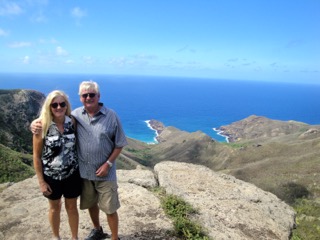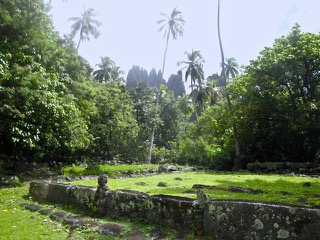What a wahoo 13° 49’.707S 143° 07’.309W

|
13° 49’.707S 143° 07’.309W en-route The Marquesas to The Tuamotus What a wahoo! We left late afternoon and sailed overnight from our anchorage in Fatu Hiva to another island called Oa Pou. It was 110nm and it is important to get the timing right so as to arrive in daylight. Although, especially with local knowledge, some anchorages could be entered at night, it is certainly something we avoid. We anchored just after midday in the small harbour. We needed to use two anchors, our normal anchor at the bow and another large anchor we set from the stern. This holds the yacht into the waves reducing roll and prevents it from swinging about too much and getting too close to other yachts. Setting the stern anchor is easy, we set the bow anchor with, depending where we are, 30 to 50 metres of chain and after checking we are holding let out another 30 – 40 meters of chain. Let the yacht fall back and drop the stern anchor off the swim platform. Take up the bow anchor chain to the original length and pull the stern anchor chain and line tight, job done and time for an arrival cold beer! The bad news is when it is time to leave. The big stern anchor is not, like the bow anchor, connected to the electric windlass and needs to be hauled in by hand. Sometimes we use a chain hook on a rope, which is then put on one of the winches and a second chain hook and rope to stop the chain falling back again after each few metres pull. This helps a lot, but it is still a difficult and if you are not careful, a dangerous hand and foot trapping process. The final lift is over the stern by hand and the older I get; I swear that damn anchor gets heavier! We were anchored next to “Seatime” a German yacht with a couple well into their seventies who had sailed from Alaska, down the West coast of the USA and Mexico before sailing across the Pacific. There were some other yachts in the anchorage that were familiar to us including “Silver Fern” sailed by a New Zealand couple completing a 10 year circumnavigation. We have met up with many yachts and you get to know people en-route and this sometimes leads to ‘sun-downers’ on board. Although the majority of yachts crossing the Pacific are sailed by couples in our age group, it is also good to meet up with young couples in their early thirties on smaller yachts doing the same thing. One such smaller yacht with a young American couple from California is appropriately named; “Tipsea”! In Oa Pou we ended up at the local cultural centre, which provides a good buffet lunch of local food for 500 Pacific Francs, about 5EUR and free wi-fi. Whilst there we met up with Xavier, who is French but has lived and worked in The Marquesas for a long time. He was an English teacher at the high school, who after retiring had bought a house on Oa Pou. He offered to take us on a tour and took us around the island in his 4 x 4 showing us the small communities on the other side of the island, a beach were we could collect some ‘flower stones’ and a place where we could climb up to one of the smaller peaks on the island. We say ‘smaller’ because Oa Pou is dominated by two very unusual and high-pointed peaks. The flower stones are sandy coloured stones with small white flower like markings on them and they are apparently only found in this location. They are washed down the river and then constantly battered by the waves on the Easterly facing beach, which is facing the prevailing wind. The “beach” is made up entirely of stones, from small pebbles to large rocks, all worn smooth by the rolling to and fro and making a wonderful rattling sound as the waves crash and recede on-shore. Xavier also explained a lot about the culture and life on The Marquesas and invited us back to his house. His garden was full of fruit trees and we had a personal pick-your-own session with him giving us pamplemousse, limes and star fruit. Our next stop was the main island of Nuku Hiva. The main anchorage and indeed so called ‘capital’ of The Marquesas is Taiohae. We hired a beefy 4 x 4 Toyota pick-up and drove around the island. The road across the top, the North of the island we were warned was like a goat track and not always recommended. Well that is a bit like when younger, if I saw a sign back home saying ‘unsuitable for motor vehicles’ I had to try it! It lived up to its name and was an excellent, if challenging, real 4 x 4 drive. The island is mainly tropical rain forest, but as you approach the West side it quickly changed into a landscape that was almost like savannah grassland. This is where the only bit of flattish land can be found on Nuku Hiva and is the area where the small airport was built. We climbed back up into the mountains, back onto a good road, in fact the best road on the island. As we climbed the topography changed again to pine forests and on that day the clouds came down and it started to rain. We both commented that it looked just like Scotland! There are some splendid bays in Nuku Hiva and we anchored and stayed in as many as we could. We hiked when we could, including up to an old and original archaeological site where Herman Melville, author of Moby Dick, lived with a native tribe after he deserted the whaling ship he had arrived on. To get there from Hanga Haa Cove we had to wait for high tide, this was so that we could take the dinghy across the sand bar at the entrance to the river on which the village is situated. Motoring up the river was very peaceful and another delightful aspect of these islands. It also meant that we couldn’t dawdle on our walk up to the site as we had to get back over the sandbar before the water became too low! In that same bay we saw a lot of dorsal fins breaking on the surface of the water, leisurely swimming around the boat. Were they small sharks or what sort of fish? We
looked and saw they were in fact quite large rays from about 1m to 1.5m across.
They swim by lifting alternate dorsal fins and this is what we could see. We
identified them as Devil Rays and there were lots of them. We went snorkelling
to see if we could swim with them, but the visibility in the water was too
poor. The next day we explored in the dingy and by drifting with the engine
off, managed to come right alongside one. It gave a big splash with its tail
and quickly departed. We took a lot of photos, not very successfully but the
best one we have added to this blog. We would like to say our fishing skills have improved but maybe it is just luck. We use a pink coloured plastic squid with quite a large hook and caught three big fish sailing between the Marquesan Islands. First was a 9kg wahoo. Neither of us had ever heard of a wahoo let alone tasted one before we sailed in tropical waters. It is a long silvery fish with pale blue wavy stripes and it tastes delicious, rather like a ‘refined’ cod fillet. We then caught a 15kg dorado or mahi-mahi as it is known and finally another very large wahoo which weighed just over 16kg. It may not look much if you are a regular subscriber to Anglers Monthly or similar, but to us that dorado and wahoo were the biggest fish we have ever caught. And by sheer length, 1.5m, - what a wahoo! We
have stopped fishing for a while, the freezer is full and Caroline worked out
we have over 40 ‘fish’ meals for two. We originally planned to stay two to three weeks in The Marquesas. In the end we have stayed six weeks and all of the lists we wrote of where we would be when, are now completely wrong. We enjoyed The Marquesas so much we just could not bring ourselves to leave. Beautiful anchorages, stunning scenery, an environment where you feel very safe and friendly helpful people were all good reasons to prolong our stay. Finally on the night of Monday 13 July, it was time to go, and after replenishing food and drinks, albeit at a price, it was time to sail to the South Sea atolls that make up the coral island group known as the Tuamotu Archipelago. A 510nm sail and another adventure was about to start. Michael & Caroline 17 July 2015. S/Y Golden Spirit of Islay       |